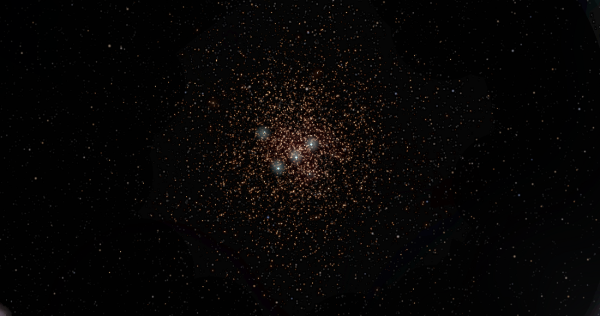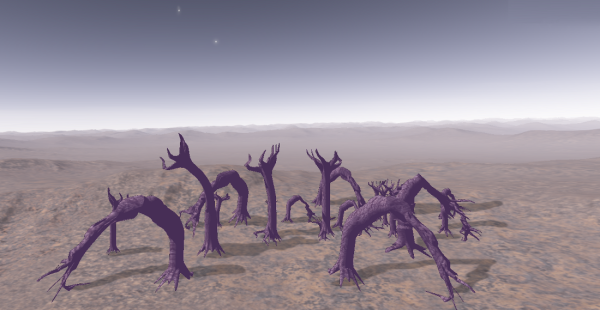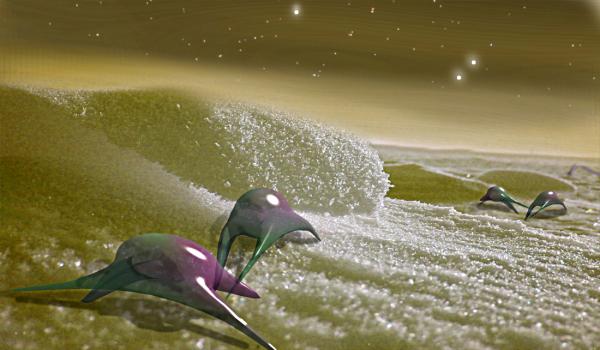BY LETTER
Messier 67
Large, old star cluster with several life-bearing worlds |
 Image from Steve Bowers |
Messier 67 is a large, old cluster in Cancer, 2940 light years from Sol. This is the second oldest open cluster in the Terragen Sphere, with an age of 4.1 billion years; only NGC 188 is older. The cluster is roughly 20ly in diameter, and stars are (on average) around 1.6 ly apart.
M 67 is nominally in Sophic League territory, although the NoCoZo and Metasoft each have a significant presence in the cluster, with wormhole links to their respective empires. The first exploration class vessels arrived in 7007 AT.
Larger than many other open clusters, M67 has remained gravitationally bound since its formation. All the giant stars which were formed in the youth of this cluster no longer exist; they have become black holes (of which there are 7), neutron stars (9) or white dwarfs (67). The 589 stars which remain are either main-sequence F, G, K or M stars, red giants(87) or the unusual class of Blue Stragglers(30) created by the collision of other stars.
Messier 67 contains a large number of terrestrial planets, many of which are life-bearing worlds. However these fall into only two xenotype classes, one Earth-like and water-based, the other SoftOneian (ammonia-based). Each xenotype is believed to have emerged in an abiogenesis event on one of the worlds in the cluster, then spread to the other worlds in the cluster at various times over the last 4.7 billion years. As well as these two separate abiogenesis events, there is evidence for a third that became extinct and left no descendant biota. The process of Lithopanspermia within clusters allows life-bearing rocks to be transferred between these close systems, wheras panspermia between stars outside of clusters is rare-to-nonexistent. Some planets were cross-infected on more than one occasion, producing multiple biota on a single world.
In total there are 97 worlds with various kinds of microbiota, both water-based and ammonia-based; and eleven worlds have developed into garden worlds with complex multicellular life. These garden worlds are very diverse, and have become the subject of study by xenobiologists from the Hamilton Institute, Eden and several other academic organisations. The current consensus among these researchers is that so-called lithopanspermia events have brought life to these many worlds; microbes of various kinds were expelled during meteoric impacts, and travelled inside rocky or dusty debris to the other worlds in the cluster, on journeys that lasted many millions of years. From such primitive beginnings, each new biosphere has developed in an entirely unique direction - apart from their molecular origins, the many biotas in M67 show little or no similarity from one world to the next. Because of the energetic events associated with the formation of the blue straggler stars, the living worlds of M67 are periodically bathed in ferocious radiation; these events occur on average every hundred million years or so. For this reason most life on this worlds is extremely radiation resistant.
Garden Worlds in M67
Koehler | |
 Image from Steve Bowers | |
| Archtrees on Koelher | |
Ferraro | |
 Image from Steve Bowers | |
| Spicularians hunting in the clathrate ice of Ferraro, with several daystars visible in the background | |
Another intriguing world is Ferraro, an icy world covered in glittering, slow-moving glassy organisms, capable of sprouting legs and other appendages almost at random, and of catching and ingesting each other in slow but determined acts of predation.
Because this cluster contains several large, luminous stars including 87 red giants and 30 blue stragglers, the skies of these worlds are very spectacular at night, and many of the stars are easily visible in daylight. Several species on these worlds use these daystars to navigate by, and use the brilliant starlight at night to hunt and for other purposes.
Both Koehler and Ferraro have been 'adopted' by Caretaker Gods, who restrict access to the surface of these worlds to a minimum. Only accredited researchers may go there, and they are required to use sterile, remote-controlled bodies devised by the Caretaker Gods, designed to blend in with the local environment and biota.
The Sophic League maintains a good relationship with the two Caretaker Gods concerned; the one controlling Ferraro is an S:3 transapient known as Zhi, while the one guarding Koehler is an S:4 known as Ku. Zhi appears to be subordinate to Ku, a rare example of interaction between Caretaker entities in close proximity.
Zhi has permitted the establishment of a secondary colony near Ferraro, where a replica biosphere has been established on a similar world; here the Sophic League and NoCoZo are working together to provolve the Spicularians, the most active phyle on Ferraro. A scientific embassy from the Soft Ones is present and is watching the process with interest; this xenosophont race from the Rimward regions of the galaxy share certain biochemical features with the Spicularians, and have some experience with provolution in low temperature species.
Ancient Xenosophont Activity
No xenosophont races have evolved naturally in this cluster, but over its long lifetime several now-vanished xenosophonts have visited and left their mark here. Species HIE236PPE (Known as the Khitai) came here two billion years ago, and remained for several million years; most of their remains are buried deep beneath the surface of the worlds they visited.Species HIE636MZE, dubbed The Makers, also left several relics, including some technology they appear to have acquired from a much older and more sophisticated race. This includes a collection of minute, empty magmatter cages in orbit around the neutron star M67-NS5. These cages may have been connected with some form of metric engineering, possibly an attempt to create miniature black holes or wormholes; but it is not possible to determine if these efforts were successful.
Another interesting relic is the World of Abandoned Dreams, a fractal ruin in a small moon that shares some features with the structure known as Miracle City in Serpens. Unlike that distant structure, the World of Abandoned Dreams has been uninhabited and decaying for ninety million years, a figure which suggests that Miracle City is at least that old.
The Diadem Swarm
Around the star LB 6335 the NoCoZo has established the so-called Diadem Swarm, a collection of diverse habitats large and small. This system is a major hub for spacecraft travel and trade within the cluster; tramp freighters and faster craft ply the routes between the NoCoZo, Metasoft and Sophic League sectors, and carry xenology teams, their equipment and occasional finds to and from the worlds of interest, or negotiate with the Caretaker Gods for limited access.Related Articles
- Abiogenesis, Lithopanspermia and Translocation
- Garden Worlds
- Open Star Clusters
- Xenobiochemistry
- Xenobiota - Text by M. Alan Kazlev
The totality of non-terragen life on a specific planet or non-terragen ecosystem.
Appears in Topics
Development Notes
Text by Steve Bowers
Todd Drashner, James Rogers, Ryan B, Tom Mazanec
Initially published on 24 December 2015.
Todd Drashner, James Rogers, Ryan B, Tom Mazanec
Initially published on 24 December 2015.






